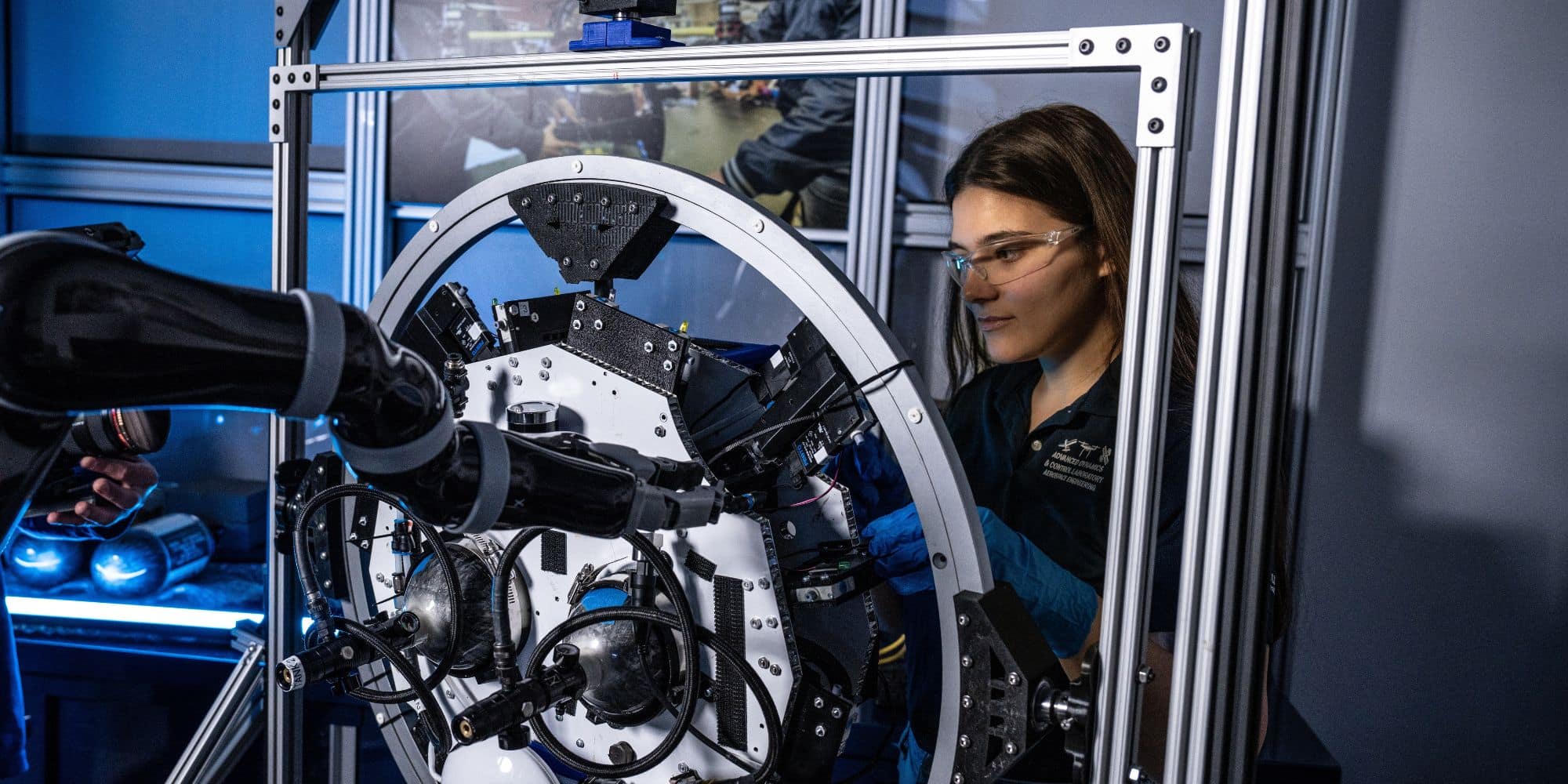

How to Become an Aerospace Engineer

Whether you dream of designing spacecraft, improving jet engines or building the next generation of electric aircraft, a career in aerospace engineering offers endless possibilities — on Earth and beyond.
Aerospace engineers are the minds behind the machines that move us through air and space. And at Embry-Riddle Aeronautical University, students don’t just learn how to become aerospace engineers — they become innovators ready to lead one of the world’s most exciting industries.
What Does an Aerospace Engineer Do?
From commercial aviation and defense to space exploration and urban air mobility, aerospace engineers solve complex problems in flight mechanics, propulsion, structures, systems and aerodynamics. Typical roles include:
- Designing and testing aircraft and spacecraft.
- Developing propulsion or navigation systems.
- Enhancing fuel efficiency and flight safety.
- Innovating with autonomous and electric aviation technologies.
Whether working for The Boeing Company, NASA, SpaceX, the U.S. Military or a cutting-edge start-up company, jobs in aerospace engineering span research, design, testing, systems integration and more.
If you're interested in pursuing this dynamic and impactful career, here are the key steps to becoming a successful aerospace engineer.
Step 1: Earn an Aerospace Engineering Degree
The first step in the aerospace engineer career path is earning a relevant bachelor’s degree. Embry-Riddle’s Bachelor of Science in Aerospace Engineering is consistently ranked among the best in the nation, offering:
- An ABET-accredited curriculum built with industry input.
- Hands-on learning from day one — designing UAVs, testing rocket propulsion and experimenting in wind tunnels.
- Specializations in Aeronautics, Astronautics or Propulsion, allowing students to tailor their path.
With residential campuses in Daytona Beach, Florida, and Prescott, Arizona, and a Worldwide Campus with online and in-person opportunities around the globe, Embry-Riddle offers world-class labs and facilities that replicate real industry environments.
Step 2: Get Real-World Experience
What sets Embry-Riddle apart is how quickly students move from textbooks to test stands. Every aerospace engineering student has opportunities to:
- Conduct research projects with faculty connected to NASA, the FAA and major aerospace companies.
- Work in high-tech facilities like the Aerospace Experimentation and Fabrication Building (ACFAB) and innovative labs like the Wind Tunnel Lab, Propulsion Lab and Space Technologies Lab.
- Join hands-on clubs like the Experimental Sounding Rocket Association (ESRA) or AIAA Design-Build-Fly that build teamwork and innovation skills.
Many students also complete internships at leading aerospace organizations, gaining invaluable industry experience and contacts that often lead directly to job offers.
"This is what makes Embry‑Riddle unique. We get to work directly with faculty who have industry experience and alumni connections at top aerospace companies,” said Aerospace Engineering alumna Olivia Wood (’25), who now works at SpaceX. “I wouldn't have had these opportunities anywhere else."
Step 3: Choose Your Specialization
Aerospace engineering is a broad field, so students can specialize in one of the following to tailor their educational journey to their goals:
- Aeronautics: Focuses on aerodynamics with wind tunnel experience, aircraft design and analysis and the stability, controllability and flight testing of aircraft.
- Astronautics: Focuses on orbital mechanics, spacecraft controls, rocket propulsion and structural analysis.
- Jet Propulsion: Focuses on air-breathing propulsion, including turbojets, turbofans and ramjet engines.
- Rocket Propulsion: Focuses on spacecraft propulsion associated with launch vehicles and space exploration.
Embry-Riddle students can also explore emerging fields such as uncrewed systems, human factors and space operations, preparing them to lead in a rapidly changing industry.
Step 4: Launch Your Career in Aerospace
With strong industry ties and career-focused support, Embry-Riddle graduates regularly secure roles at:
- The Boeing Company, Lockheed Martin, RTX Corporation and Northrop Grumman.
- NASA, SpaceX, Blue Origin and Sierra Space.
- The U.S. military and defense contractors.
- Emerging companies in electric vertical takeoff and landing (eVTOL) technology.
Career paths range from research and design to operations and systems engineering — often leading to leadership roles or continued education.
With an industry growth of 6% over the next decade, an estimated 4,500 job openings for aerospace engineers are projected each year, according to the U.S. Bureau of Labor Statistics.
Why Embry-Riddle?
As the world’s largest and most respected university specializing in aviation and aerospace education, we are the first choice for thousands of aspiring engineers each year. Here’s why:
- Small class sizes with personal access to faculty mentors.
- Access to state-of-the-art facilities, from rocket labs to space payload design.
- A culture of innovation, research and student-driven projects.
- A powerful alumni network across NASA, defense organizations and global aerospace companies.
With a 95% placement rate within one year after graduation, Embry-Riddle aerospace engineers launch successful careers that make a difference in the world. Many Embry-Riddle graduates also pursue advanced degrees in aerospace engineering, systems engineering or space operations — continuing their education while shaping the future of aviation and space.
Your Aerospace Career Starts Here
The journey to becoming an aerospace engineer starts out with curiosity — and launches with the right education and support. At Embry-Riddle, students gain the technical skills, hands-on experience and confidence to thrive in a rapidly evolving field. Explore aerospace engineering degrees at Embry-Riddle and take the first step toward a high-flying future.
Insights
 Worldwide College of Aviation Associate Professor Dr. Linda Vee Weiland shares insights and knowledge on the air traffic industry.
Worldwide College of Aviation Associate Professor Dr. Linda Vee Weiland shares insights and knowledge on the air traffic industry.
How to Become an Air Traffic Controller Explore human factors psychology, a field that blends psychology, engineering and design to improve safety, efficiency and user experience.
Explore human factors psychology, a field that blends psychology, engineering and design to improve safety, efficiency and user experience.
What is Human Factors Psychology Learn how to become an aerospace engineer at Embry-Riddle Aeronautical University. Discover diverse careers, hands-on experiences and specializations in the aerospace industry.
Learn how to become an aerospace engineer at Embry-Riddle Aeronautical University. Discover diverse careers, hands-on experiences and specializations in the aerospace industry.
How to Become an Aerospace Engineer




